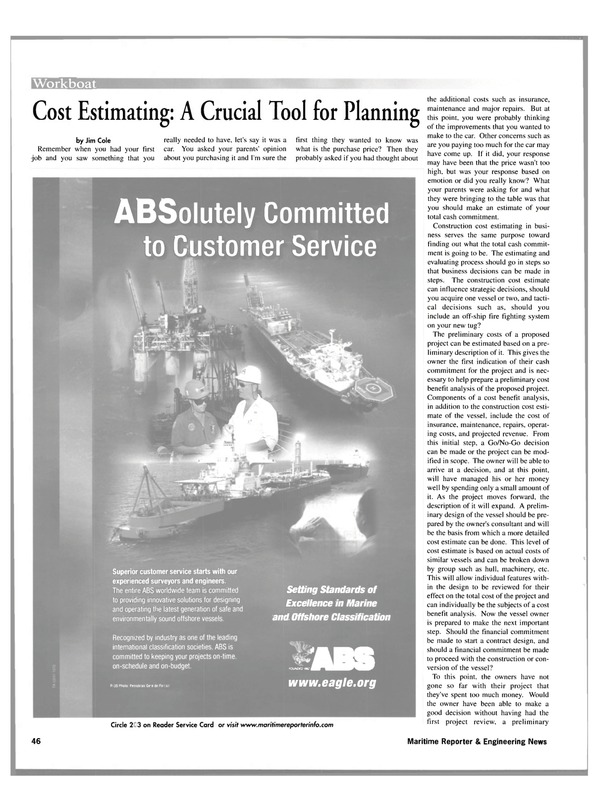
Cost Estimating: A Crucial Tool for Planning
Remember when you had your first job and you saw something that you really needed to have, let's say it was a car. You asked your parents' opinion about you purchasing it and I'm sure the first thing they wanted to know was what is the purchase price? Then they probably asked if you had thought about the additional costs such as insurance, maintenance and major repairs. But at this point, you were probably thinking of the improvements that you wanted to make to the car. Other concerns such as are you paying too much for the car may have come up. If it did, your response may have been that the price wasn't too high, but was your response based on emotion or did you really know? What your parents were asking for and what they were bringing to the table was that you should make an estimate of your total cash commitment.
Construction cost estimating in business serves the same purpose toward finding out what the total cash commitment is going to be. The estimating and evaluating process should go in steps so that business decisions can be made in steps. The construction cost estimate can influence strategic decisions, should you acquire one vessel or two, and tactical decisions such as, should you include an off-ship fire fighting system on your new tug?
The preliminary costs of a proposed project can be estimated based on a preliminary description of it. This gives the owner the first indication of their cash commitment for the project and is necessary to help prepare a preliminary cost benefit analysis of the proposed project.
Components of a cost benefit analysis, in addition to the construction cost estimate of the vessel, include the cost of insurance, maintenance, repairs, operating costs, and projected revenue. From this initial step, a Go/No-Go decision can be made or the project can be modified in scope. The owner will be able to arrive at a decision, and at this point, will have managed his or her money well by spending only a small amount of it. As the project moves forward, the description of it will expand. A preliminary design of the vessel should be prepared by the owner's consultant and will be the basis from which a more detailed cost estimate can be done. This level of cost estimate is based on actual costs of similar vessels and can be broken down by group such as hull, machinery, etc.
This will allow individual features within the design to be reviewed for their effect on the total cost of the project and can individually be the subjects of a cost benefit analysis. Now the vessel owner is prepared to make the next important step. Should the financial commitment be made to start a contract design, and should a financial commitment be made to proceed with the construction or conversion of the vessel?
To this point, the owners have not gone so far with their project that they've spent too much money. Would the owner have been able to make a good decision without having had the first project review, a preliminary design, and two levels of a construction cost estimate? No, without a construction cost estimate, the decisions would have been subjective and the design features of the vessel would probably not have been reviewed. Making a decision without careful analysis of the vessel and its cost would be much worse than your having made an impulse purchase of that car you discussed with your parents.
As the project moves on to the contract design phase, the owner should have his or her consultants prepare a construction cost estimate. Design features can be selected or rejected based on their affect on vessel cost, as a welldeveloped construction cost estimate will enable the owner to change plans accordingly. As you journey from contract design to the bidding process, the owner will be armed with data that has the vessel cost broken down by cost group. This will help in the selection of a shipyard, because the owner can compare the shipyard's estimates to his own.
Large differences in the overall cost or among the cost items can be resolved before a contract is signed, and any differences in interpretation or intent can be resolved. Construction cost estimating is a serious responsibility for shipyards.
They too need to understand what their commitment will be in labor, materials and services, and what their revenues will be for the project. The contents of the shipyard's construction cost estimate can be used to create a construction schedule that can be met and the owner, who has an estimate of his own. will be able to verify the ship- yard's schedule. Owners cannot afford to lose revenues by finding out too late that their vessel will not be delivered on time. Cost overruns and change orders are things to avoid as well.
The cost estimate, like a good sketch or draft of a document, starts the planning process out on the right track. If the client has paid for a well-based estimate, they will be able to forecast the amount of their capital commitment and can plan, schedule, and modify the design, if necessary, all in the interest of managing their money. The benefits of construction cost estimates are that they provide the client with dollar figures that are vital to the proper budgeting, planning, and tracking of projects. This applies to repair projects, as well as new construction or conversion projects. A thorough estimate provides guidance for a project in the same manner as good navigational data is needed for a safe voyage.
Read Cost Estimating: A Crucial Tool for Planning in Pdf, Flash or Html5 edition of November 2001 Maritime Reporter
Other stories from November 2001 issue
Content
- Setting A New Course page: 6
- Towards the Intelligent Engine page: 8
- High-Speed Debut on the Lakes page: 9
- FGH Announces Two N e w Contracts page: 10
- IZAR Races Ahead With New Transmed Ferry page: 12
- NASSCO Wins $ 7 0 8M T-AKE Contract page: 19
- Austal Wins Two Contracts page: 20
- CIT Takes Issue With Customs' Duty Calculation in Dry-Docking Case page: 21
- NORSHIPCO Weathers the Economic Storm page: 24
- Newport News Shipbuilding: A City Within A Shipyard page: 25
- Mobile Yard Stays Busy With Offshore Work page: 28
- Shiprepair Forum Changes to Reflect Current Events page: 30
- A&P Shipcare Stays Busy page: 32
- Cochin Shipyard Is Poised For Growth page: 33
- HSR Completes GLM Rig Upgrades page: 34
- Where Is the All-Electric Navy? page: 36
- Deepwater One Delivers $ 2 . 3B Proposal to USCG page: 44
- Cost Estimating: A Crucial Tool for Planning page: 46
- Taylor To Head Tidewater page: 48
- Brinson N e w N W C Chairman page: 48
- Marco Shipyard: Rolling With The Changes page: 51
- Bollinger Delivers Patrol Boat page: 58
- Tug Automation Control System Helps Eliminate False Alarms page: 61
- Keeping an Eye on Fuel Costs page: 67
- $120M NYC Ferry Deal Goes To Manitowoc Marine Group page: 73
- I M O Adopts Anti-Fouling Convention page: 75
- Security is Synonymous With Safety page: 76
- Liebherr Enjoys Success In Far East page: 82


